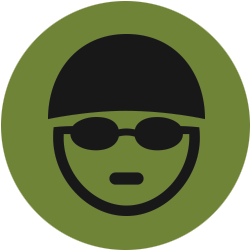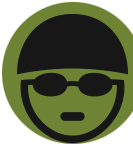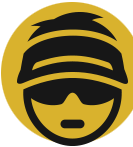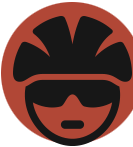Novice
Riders
As a novice cyclist, you are searching for a safe and pleasurable ride. Jump-start your new cycling lifestyle here in our Novice section. The green prompts are your pathways to success. Look for the green cyclist icon as show here on the page.
Tire Pressure
Check tire pressure before every ride. Riders often overlook pressurizing tires and ride on under inflated tires. This can increase the chances of pinch-flats. Inflating to the maximum pressure, however, is often too much. Tires that have too much pressure are more susceptible to punctures and wear faster. Also be careful about keeping your bike in the car in the summer, the tube may burst or go flat.
Chains
The chain is a critical part of the bike’s performance and safety. Clean and lube it often. Most chains should be changed after about 2,000 miles but there are tools available to check for chain stretch. When purchasing a new chain, know if you need an 8, 9 or 10 speed chain. You will need a special chain tool to remove and replace the chain, unless you have a master link. Measure the new chain again the old chain once it is removed. If you are unsure how to do this, visit a local bike shop and they will replace the chain for you for a small fee.
Seat Height
Correct seat position allows for a slight bend, about 30 percent, in the knee at the bottom of the pedal stroke. You’re not supposed to reach the ground while sitting on the seat. A low saddle stresses the tendon that connects your kneecap to your tibia. A high position forces you to reach for the pedals, which can strain the tendons in the back of the knee, so if your knee hurts in the back, lower your seat. If it hurts in the front, raise your seat, but only move it in small increments until you reach the best height for you. All this assumes your bike is the correct size for you.
Cotton
Don’t wear it unless absolutely necessary. Cotton soaks up moisture and can cause chafing or blisters.
Fuel
Drink before you’re thirsty and eat before you’re hungry. Some believe you should drink every 15 minutes and eat every 15 miles. Hunger and thirst signals mean that your body is already lacking something. You don’t want to bonk it can be ugly. Handy fast snacks include; gels, Fig Newton’s, food bars, honey, trail mix and PB&J. This is especially important when riding more than 50 miles.
You really need to pay attention to eating nutritious foods and stay well hydrated in the days prior to a long ride. In addition, make sure you bring more water and food than you think you’ll need on the ride. On rides longer than an hour, a recovery drink should be consumed within 20 minutes after getting off the bike.
Pedals
Ditch the flat pedals and toe clips, you will become more efficient when pedaling with clipless pedals. With clipless pedals you can learn to pedal more efficiently. Imagine tracing a circle with your heel: concentrate on pulling up, pushing the pedal across the top, and pulling backward at the bottom as if you’re trying to scrape mud off the sole of your shoe.
Gears
Shift your gears. When you slowly push hard gears your leg muscles do most of the work. Spinning smaller gears and pedaling faster transfers the workload to your aerobic system. You’ll find a sweet spot where no part of your body feels like it’s working too hard. So if you’re tired in the legs, shift to an easier gear. If you’re tired in the lungs, shift to a harder gear.
Also, remember to clean your cassette at least monthly. If shifting is rough, makes a lot of noise or the chain skips, the cables may have stretched and you will need an adjustment. If you are unsure of how to do this, visit a local bike shop and they will do it for you for a small fee or possibly no fee if you purchased the bike at the shop.
Road Rules
Hold your line, don’t cross the center line, ride no more than two abreast, don’t ride on the shoulder, obey the traffic signs and signals, ride and act like you are driving a car. Check your state’s Department of Transportation for more information about cycling safety.





